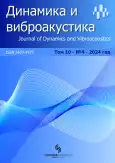Разработка конечно-элементной модели резонатора для вибрационного сигнализатора уровня камертонного типа
- Авторы: Бражников А.М.1, Ганигин С.Ю.1
-
Учреждения:
- СамГТУ
- Выпуск: Том 10, № 4 (2024): 30.12.2024
- Страницы: 54-62
- Раздел: Статьи
- URL: https://bakhtiniada.ru/2409-4579/article/view/312328
- DOI: https://doi.org/10.18287/2409-4579-2024-10-4-54-62
- ID: 312328
Цитировать
Полный текст
Аннотация
В статье представлены результаты разработки конечно-элементной модели резонатора вибрационного сигнализатора уровня камертонного типа. Модель разработана в программном продукте Ansys Workbench. Предложены варианты оценки характеристик резонатора, включающие прочностной, модальный, гармонический анализы. Разработана модель свободных затухающих колебаний резонатора, включающую динамический прочностной расчёт в сочетании с модулем вычислительной гидродинамики. Модель позволяет производить оценку частоты колебаний резонатора в жидкостях с различными плотностями и вязкостями. Результаты моделирования сопоставлены с лабораторными экспериментами. Сравнение показало отклонение по резонансным частотам не более 7%. Результаты моделирования будут использованы для проведения структурной оптимизации геометрии резонатора для расширения диапазона плотностей и вязкостей рабочих жидкостей сигнализатора уровня.
Об авторах
А. М. Бражников
СамГТУ
Автор, ответственный за переписку.
Email: artembragnicov@yandex.ru
аспирант
Россия, г. СамараС. Ю. Ганигин
СамГТУ
Email: ganigin.s.yu@yandex.ru
доктор технических наук, заведующий кафедрой «Радиотехнические устройства»
Россия, г. СамараСписок литературы
- Roshani, G. H. Online measuring density of oil products in annular regime of gas liquid two phase flows / S. Roshani, E. Nazemi, S. Roshani // Measurement. – 2018. – vol. 129, pp. 296–301.
- Зацерклянный, О. В. Исследование и разработка прецизионного плотномера жидкостей и газов на основе камертонного вибропреобразователя : диссертация … кандидата технических наук / Зацерклянный Олег Владимирович. – Новочеркасск, 2021 г.
- Богуш, М. В. Вибрационные сигнализаторы уровня для магистральных газопроводов / А. А. Гарковец, Э. М. Пикалев, А. Е. Панич // НКТБ «Пьезоприбор» ЮФУ, ООО «Пьезоэлектрик» Ростов-на-Дону.
- Gonzalez, M. Downhole viscosity measurement platform using tuning fork oscillators / M. González, G. Ham, A. A. Haddad, G. Bernero, M. Deffenbaugh // 2015 IEEE SENSORS. – November 2015.
- Jakoby, B. Miniaturized sensors for the viscosity and density of liquids-performance 16 Mathematical Problems in Engineering and issues / R. Beigelbeck, F. Keplinger et al. // IEEE Transactions on Ultrasonics, Ferroelectrics and Frequency Control. – 2010. – vol. 57, no. 1. – pp. 111–120.
- Guan, Y. Performance analysis of a microfluidic pump based on combined actuation of the piezoelectric effect and liquid crystal backflow effect // Micromachines. – 2019. – vol. 10, no. 9.
- Haozhi, Q. Quasistatic nonlinear analysis of a drill pipe in subsea xmas tree installation / J. Liu, W. Xiao, B. Wang // Mathematical Problems in Engineering. – 2019. – vol. 2019. – Article ID 4241363. – 9 pages.
- Hai, Y. Research on Tuning Fork Dimension Optimization and Density Calculation Model Based on Viscosity Compensation for Tuning Fork Density Sensor / Yang Hai, Rao Yue, Li Li, Liang Haibo, Luo Tao, Xin Gaifang // Hindawi Mathematical Problems in Engineering. – 2020. – Article ID 7960546. – 17 pages.
Дополнительные файлы









